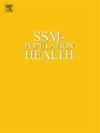重创:2019冠状病毒病大流行对西班牙裔/拉丁裔人口生育的影响
IF 3.1
2区 医学
Q1 PUBLIC, ENVIRONMENTAL & OCCUPATIONAL HEALTH
引用次数: 0
摘要
2019冠状病毒病对西班牙裔/拉丁裔工作年龄人群的影响令人担忧,这促使我们关注于确定与非西班牙裔白人女性相比,2019冠状病毒病大流行对西班牙裔女性生育能力的影响是否存在差异。方法利用州级出生统计数据,我们使用各州特定的分段回归模型进行中断时间序列(ITS)分析,以评估大流行对美国出生的西班牙裔妇女、移民西班牙裔妇女和非西班牙裔白人妇女在大流行前后五个不同时期的生育率的影响。我们提出了差异中差异(DiD)估计来评估大流行对每组妇女生育的影响,并提出了差异中差异(DDD)估计来确定美国出生或移民的西班牙裔妇女是否比非西班牙裔白人妇女经历了更明显的大流行生育影响。结果不同的州和人口亚组在大流行前和大流行后的生育趋势都有很大的差异。我们发现,无论大流行前的生育率趋势如何,从2020年3月到2021年2月,几乎所有州的西班牙裔移民妇女的出生率都低于预期。相比之下,大多数州的非西班牙裔白人女性从2020年12月到2022年12月经历了“婴儿潮”。在此期间,在美国出生的西班牙裔妇女的模式变化更大,大约一半的州的出生率低于预期,而另一半的州则出现了“婴儿潮”。然而,与非西班牙裔白人相比,两组西班牙裔妇女在大流行高峰期(2020年12月至2021年2月)对生育率的影响更为明显。就生育率而言,几乎在所有州,外国出生的西班牙裔美国人在2020年12月至2021年2月期间对出生率产生了明显且不成比例的负面影响,随后是到2022年12月的婴儿潮。建立这些模式是全面考虑这一流行病对我国人口影响程度的一个关键部分,特别是它如何改变了西班牙裔美国人等受到严重打击的亚群体的人口进程。本文章由计算机程序翻译,如有差异,请以英文原文为准。
Hard Hit: The impact of the COVID-19 pandemic on childbearing in the Hispanic/Latino population
Objectives
The alarmingly disproportionate impact of COVID-19 on the working age segment of the Hispanic/Latino population motivates our focus on determining whether the COVID-19 pandemic differentially impacted the fertility of Hispanic women compared to non-Hispanic White women.
Methods
Leveraging state-level birth count data, we perform an interrupted time-series (ITS) analysis using state-specific, piece-wise regression models to assess pandemic impacts on fertility across five different pre- and post-pandemic periods for U.S.-born Hispanic women, immigrant Hispanic women, and non-Hispanic white women. We present difference-in-differences (DiD) estimates to assess the impact of the pandemic on births to each group of women and difference-in-difference-in-differences (DDD) estimates to determine if U.S.-born or immigrant Hispanic women experienced more pronounced pandemic fertility impacts compared to their non-Hispanic White counterparts.
Results
There was substantial variability in both pre- and post-pandemic fertility trends by state and population sub-group. We find that immigrant Hispanic women in nearly all states had fewer births than expected from March 2020 through February 2021, irrespective of pre-pandemic fertility trends. In contrast, non-Hispanic white women in most states experienced a “baby boomlet” from December 2020 through December 2022. U.S.-born Hispanic women have a more variable pattern during this period, with fewer births than expected in about half of the states, and a “baby boomlet” in the other half. Relative to non-Hispanic whites, however, both groups of Hispanic women experienced more pronounced depressive pandemic impacts on fertility at the height of the pandemic (December 2020–February 2021).
Discussion
Mirroring disproportionate impacts on mortality, in the case of fertility, in nearly all states, foreign-born Hispanic Americans experienced pronounced and disproportionately negative impacts on births from December 2020 through February 2021, followed by a baby boomlet through December 2022. Establishing these patterns is a critical piece of a full accounting of the extent of the pandemic's influence on our country's demography, particularly how it has altered the population processes of such hard-hit sub-populations as Hispanic Americans.
求助全文
通过发布文献求助,成功后即可免费获取论文全文。
去求助
来源期刊

Ssm-Population Health
PUBLIC, ENVIRONMENTAL & OCCUPATIONAL HEALTH-
CiteScore
6.50
自引率
2.10%
发文量
298
审稿时长
101 days
期刊介绍:
SSM - Population Health. The new online only, open access, peer reviewed journal in all areas relating Social Science research to population health. SSM - Population Health shares the same Editors-in Chief and general approach to manuscripts as its sister journal, Social Science & Medicine. The journal takes a broad approach to the field especially welcoming interdisciplinary papers from across the Social Sciences and allied areas. SSM - Population Health offers an alternative outlet for work which might not be considered, or is classed as ''out of scope'' elsewhere, and prioritizes fast peer review and publication to the benefit of authors and readers. The journal welcomes all types of paper from traditional primary research articles, replication studies, short communications, methodological studies, instrument validation, opinion pieces, literature reviews, etc. SSM - Population Health also offers the opportunity to publish special issues or sections to reflect current interest and research in topical or developing areas. The journal fully supports authors wanting to present their research in an innovative fashion though the use of multimedia formats.
 求助内容:
求助内容: 应助结果提醒方式:
应助结果提醒方式:


